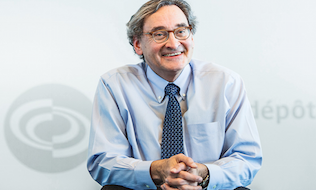

The Caisse de dépôt et placement du Québec returned 9.3 per cent in 2017, an increase on its return of 7.6 per cent in 2016.
While announcing the annual results on Wednesday, Michael Sabia, president and chief executive officer of the Caisse, said the portfolio reacted almost exactly as forecasted. He also highlighted the important transition period that global investors are currently facing. “Since the crisis, what has been the engine of the market . . . is clearly the monetary policies of the banks,” he said, noting the U.S. Federal Reserve has started to adjust itself to the new reality, marking a huge transition on the part of the central bank. “So the volatility we’re experiencing now is not at all surprising. The thing that is surprising is this volatility did not appear many months ago.”
Read: Caisse focuses on ‘all-terrain portfolio’ as return drops to 7.6%
The Caisse repositioned its fixed-income assets in 2017, a strategy aimed at diversifying the fund’s activities by reducing exposure to the traditional bond market and increasing its credit activities, including corporate and sovereign credit and specialty finance. “This diversification, in our opinion, has bore some fruit because the credit portfolio has delivered a return of 5.1 per cent, compared to 1.8 for the rates portfolio . . . which are more or less government bonds,” said Sabia.
It was another good year for the equity market, he noted, especially in the United States and emerging economies. The Caisse returned 13.6 per cent in equities in 2017, with net equity assets reaching $149.5 billion as of Dec. 31, 2017.
The results show the pension fund has expanded its international exposure significantly for a total of more than $190 billion invested globally today.
“This process of globalization, which is well underway, is a primordial element of our plan, and this is for a simple reason. In order to deliver the returns that Quebecers will need to receive in the future, we need to have the means to find and carry out and close the best transactions wherever they are in the world. Obviously, we are making progress,” said Sabia.
“I think we have a pretty good momentum,” he added, noting the Caisse has put the emphasis on two main geographic regions: the United States and emerging countries. “Frankly, this exposure to emerging countries paid off nicely, certainly in 2017 but also in 2016, because these assets performed very well.”
Locally, the fund put $6.7 billion in new investments and commitments in Quebec for a total of $63.4 billion in the province. The Caisse now partners with more than 750 companies, including about 650 small and medium-sized employers in the private sector.
Read: Caisse takes stake in Quebec-based Groupe Solmax
Read: Caisse buys shares in Montreal-based investment firm
In the past three or four years, the Caisse has completely restructured its view of investing in Quebec with a single objective of putting an emphasis on the private sector, said Sabia. “Because we think the private sector is the engine of economic development and also the engine of job creation in Quebec.”
Looking at the Caisse’s real assets portfolio, which includes infrastructure and real estate, it returned 8.7 per cent in 2017, with total net assets reaching $50.4 billion at the end of the year. Its real estate subsidiary, Ivanhoé Cambridge, was active in the logistics and light industrial sector, which is benefiting from the global growth in e-commerce, according to the results.
On the infrastructure side, the Caisse acquired a significant stake in eight Mexican wind and solar farms operated by Enel Green Power North America Inc. It also invested more than $390 million in Quebec wind energy producer Boralex Inc. With more than $16 billion in infrastructure around the world, the Caisse has doubled its holdings over five years ago, according to the results.
